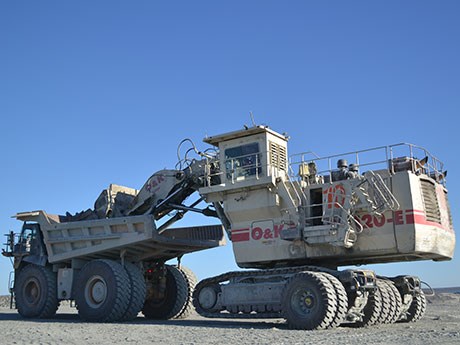Detour Gold puts 297-tonne Caterpillar 6030 on wheels
How do you move a 297-tonne Caterpillar 6030 excavator around an open pit? With great difficulty.
Ossi Kortesalmi, who spent years working with excavators at the Elijarvi chrome mine in Finnish Lapland, knew there had to be a faster, safer and less expensive way to move these behemoths around a mine site. Kortesalmi came up with an ingenious solution, went into business in 1996 and is now selling his Sleipner system worldwide.
Detour Gold, which achieved commercial production last year at its open pit mine 185 kilometres northeast of Cochrane, took delivery in January of the second Sleipner system to make its way to Canada. The first one was acquired by Agnico-Eagle’s Meadowbrook Mine in Nunavut.
The Sleipner system is a wheeled transporter that accepts and locks the excavator’s tracks in place. The excavator operator rides up on it, swivels around, rests the bucket on a cushion of material in the bed of a haul truck and off they go.
With the tracks elevated some 17 inches off the ground, the excavator can be hauled at speeds of up to 10 to 15 kilometres per hour, depending on the grade, versus the two kilometres per hour for a big excavator travelling on tracks.
“The bigger excavators have two diesel engines and consume a lot of fuel,” said Randall Scott, president of Mining Solutions Inc., the Sleipner dealer for Canada and South America. “All the weight is on the steel tracks, so there’s a lot of friction buildup between the pins and the track pads and it gets extremely hot.”
The Sleipner system (Sleipner in Norse mythology is an eight-legged horse) cuts down on excavator maintenance costs.
And in far northern climates, it allows for more efficient mobilization to a garage versus having to perform maintenance in minus 40-degree temperatures.
“Excavators are moved around a lot,” said Scott. “Depending on the mine and the planning, they can be moved daily and sometimes twice a day to clear an area for blasting or to access a different grade of ore for the plant.”
Transporters, or lowboys, are often used to mobilize excavators, “but once you get above 250 to 300 tonnes, they’re so expensive,” said Scott. “A lowboy to haul a 297-tonne excavator around a mine site would probably cost in excess of $5 million, and is a maintenance nightmare. You also need a dedicated truck because of the modifications that have to be done to it.”
A Sleipner E310 sells for considerably less.
Loading is also more complicated with a lowboy because of the requirement for spotters and other mine personnel for securing the excavator. The Sleipner system requires no additional personnel and there’s no one in harm’s way.
“We’re so much safer than a lowboy,” said Scott. “A lowboy is two to three feet off the ground, which raises the centre of gravity. We’re four wheels wider than the excavator and only 17 inches off the ground, so the centre of gravity is actually lower than it is when operating out in the pit loading a truck.”
The lower the centre of gravity, the less risk there is of tipping.
There are currently 11 Sleipner systems in operation in South America, two in Canada and none in the U.S., according to Scott.



